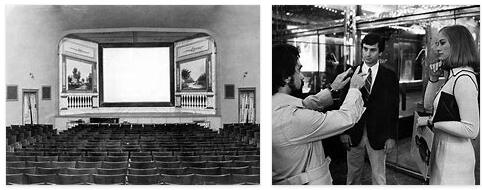CULTURE: CINEMA. THE EMERGENCE OF UNDERGROUND CINEMA AND THE OTHER FORTUNES OF HOLLYWOOD
The new reality gave way to other experiences: co-production initiatives and independent producers multiplied, experimental films were made and, after the impositions of McCarthyism, it was time for films on freedom of thought. Hollywood, however, still insisted on the show, although by the 1960s it had added the policy of good quality to its objectives, while independent American cinema followed other paths and in 1960 a group of avant-garde directors constituted, in controversy with the current production, the New American Cinema. This trend, in which the underground merged, he concentrated in New York hoping for a cinema “not rosy, but the color of blood”, an experimental cinema of poetry and formal renewal, not integrated into the prose of industry and the system; but as a “third avant-garde” movement it exhausted its breaking function in a few years (until 1967), leaving the names of the leading film-makers (from K. Anger to J. and A. Mekas, from S. Brakhage to G. Markopoulos), while the forefather of pop art, A. Warhol, was in turn absorbed by the trade, especially through the films of his mediator P. Morrissey. From Shadows (1960; Ombre) to A Woman Under the Influence (1974; A wife) J. Cassavetes instead he went on his own personal journey, mirror of a different America. In the 1960s, Hollywood’s death was too often proclaimed, which, on the other hand, was able to be reborn, resizing itself in the face of the new situation. Audience, takings, number of films, everything decreased or even halved, the empire of major companies dissolved overwhelmed by the crack of the colossals (Cleopatra, 1962), television as a new “dream factory” had captured a “homogeneous” America, while young people (70% of the audience) demanded another type of cinema. The “American dream”, already expired, would then be shattered in Vietnam and with Watergate. The cinema industry reacted to all this by containing expenses and restructuring the plants: with coldness, high finance and multinationals took over from the producers of the past, taking over the new cinema but leaving them more freedom of movement. Thus it established itself, anticipated at the time by a producer-filmmaker such as S. Kramer (Judgment at Nuremberg 1961; Winners and losers), a large generation of directors-producers and actors, screenwriters, operators more or less autonomous, endowed with enormous and even exasperated professionalism, and who in the seventies was also characterized by the Italian origin of several of its exponents (F. Ford Coppola, M. Scorsese, B. De Palma, R. De Niro, V. Storaro, C. Rambaldi etc.). Staying away from Hollywood, the continent was rediscovered in low-cost but highly successful travel films, the progenitor of which was, in 1969, Easy Rider. The ideological constraints of the past were answered with an unprecedented commitment of thought, even if Kubrick moved away from America to express it (Doctor Strangelove, 1964; Doctor Strangelove, 2001 A Space Odyssey, 1968; 2001 A Space Odyssey).
CULTURE: CINEMA. FROM THE PROTEST OF THE SEVENTIES TO THE NEW BLOCKBUSTERS
Around 1970 many protestant instances emerged in the cinema of youth protest (later, however, the ebb would set in). But also in traditional cinema a revolution took place: all genres, from the western with S. Peckinpah to the gangster film with A. Penn, from the retro with P. Bogdanovich to the comic with W. Allen, found new echoes in anguish or in nostalgia, in violence or eros; or they were emptied from the inside as in the work of R. Altman, whose masterpiece Nashville (1975) turned out to be a great critical metaphor of America on the threshold of the bicentennial. Even purely spectacular cinema appeared linked to the anxieties and traumas of society, drawing from it, almost as a paradox, its excellent state of economic health through the return to the genres typical of periods of hardship such as the black vein, the police-political one, the catastrophic, irrational or mystical science fiction etc. In Coppola’s billionaire films, from The Godfather (1972; Godfather) to Apocalypse Now (1979), the mafia and Vietnam also became a spectacle. In those of G. Lucas (from Star Wars, Star Wars, 1976, to Return of the Jedi, Return of the Jedi, 1983) and S. Spielberg (from Jaws, Lo shark, 1975, to ET, 1982) the box office records were overwhelmed by resorting to special effects cinema, which was followed in the 1980s by electronic ones. But almost always new technological discoveries are matched by the banality of narrative contents (with the exception of ET where the relationship between the child and the extraterrestrial has the charm of the classic fable in a futuristic context). On the other hand, the transformation of young talents into gigantic money machines was one of the victories of the new Hollywood. To which the cinema that defines itself as “independent” tends, to a very large extent, and which between the Seventies and Eighties presents itself with a spirit and ambitions exactly the opposite of the underground of the sixties. Curiously, the same global success of Hollywood cinema caused an artistic and economic crisis during the 1980s. The need to maintain the economic-commercial hegemony on all international markets has led the great American cinema to impoverish the narrative aspect in favor of special effects and entertainment formulas that are as ecumenical as possible. Furthermore, the exaggerated levitation of costs has often produced sensational industrial crises, such as those of Columbia, taken over in 1989 by Japanese capital, or the difficulties of MGM, the failures of Cannon and Dino De Laurentiis.
